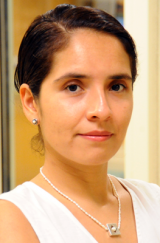
WAW 2015 - Invited Speakers
WAW 2015 - Invited Speakers
Invited Speakers
Paul Van Dooren, Catholic University of Louvain
Title: Judging the judges: iterative filtering and dynamic reputation systems.
 Abstract: The talk introduces a novel iterative method that assigns a reputation
to n+m items: n judges and m objects. Each judge evaluates a subset of
objects leading to a n x m rating matrix with a certain sparsity
pattern. From this rating matrix we give a nonlinear formula to define
the reputation of judges and objects. We also provide an iterative
algorithm that superlinearly converges to the unique vector of
reputations for any rating matrix. In contrast to classical
outliers detection, no evaluation is discarded in this method but each
one is taken into account with different weights for the reputation of
the objects. The complexity of one iteration step is linear in the
number of evaluations, making our algorithm efficient for large data
set. Experiments show good robustness of the reputation of the objects
against cheaters and spammers and good detection properties of
cheaters and spammers.
Abstract: The talk introduces a novel iterative method that assigns a reputation
to n+m items: n judges and m objects. Each judge evaluates a subset of
objects leading to a n x m rating matrix with a certain sparsity
pattern. From this rating matrix we give a nonlinear formula to define
the reputation of judges and objects. We also provide an iterative
algorithm that superlinearly converges to the unique vector of
reputations for any rating matrix. In contrast to classical
outliers detection, no evaluation is discarded in this method but each
one is taken into account with different weights for the reputation of
the objects. The complexity of one iteration step is linear in the
number of evaluations, making our algorithm efficient for large data
set. Experiments show good robustness of the reputation of the objects
against cheaters and spammers and good detection properties of
cheaters and spammers.
Mariana Olvera-Cravioto, Columbia University
Title: Distances, clustering and PageRank on the directed configuration model.
 Abstract: This talk will give an overview of recent results for directed configuration networks, including:
Abstract: This talk will give an overview of recent results for directed configuration networks, including:
- A characterization of the typical distances between two randomly chosen nodes exhibiting an interesting behavior that depends on the level of correlation between the in-degree and out-degree;
- A description of a simple re-wiring mechanism to obtain various levels of clustering, capable of favoring different types of triangles.
- A rigorous analysis of the distribution of PageRank establishing its convergence to a distributional fixed point equation, which among other things can be used to explain why PageRank has a power-law distribution with the same index as the in-degree in the scale-free setting.
We will also discuss possible extensions to different random graph models and mention a few open problems.
[This is joint work with Ningyuan Chen, Nelly Litvak, Pim van der Hoorn, and Glen Kushta.]
Remco van der Hofstad, Eindhoven University
Title: Scale-free percolation.
 Abstract: We propose and study a random graph model on the hypercubic lattice that interpolates between models of scale-free random graphs and long-range percolation.
In our model, each vertex $x$ has a weight $W_x$, where the weights of different vertices are i.i.d. random variables. Given the weights, the edge between $x$ and $y$ is, independently of all other edges, occupied with probability $1-e^{-\lambda W_xW_y/|x-y|^{\alpha}}$, where
Abstract: We propose and study a random graph model on the hypercubic lattice that interpolates between models of scale-free random graphs and long-range percolation.
In our model, each vertex $x$ has a weight $W_x$, where the weights of different vertices are i.i.d. random variables. Given the weights, the edge between $x$ and $y$ is, independently of all other edges, occupied with probability $1-e^{-\lambda W_xW_y/|x-y|^{\alpha}}$, where
- $\lambda$ is the percolation parameter,
- $|x-y|$ is the Euclidean distance between $x$ and $y$, and
- $\alpha$ is a long-range parameter.
The most interesting behavior can be observed when the random weights have a power-law distribution, i.e., when $P(W_x>w)$ is regularly varying with exponent $1-\tau$ for some $\tau>1$. In this case, we see that the degrees are infinite a.s. when $\gamma =\alpha(\tau-1)/d <1$, while the degrees have a power-law distribution with exponent $\gamma$ when $\gamma>1$. Our main results describe phase transitions in the positivity of the critical value and in the graph distances in the percolation cluster as $\gamma$ varies. Let $\lambda_c$ denote the critical value of the model. Then, we show that $\lambda_c=0$ when $\gamma<2$, while $\lambda_c>0$ when $\gamma>2$. Further, conditionally on 0 and $x$ being connected, the graph distance between 0 and $x$ is of order $\log\log|x|$ when $\gamma<2$ and at least of order $\log|x|$ when $\gamma>2$. These results are similar to the ones in inhomogeneous random graphs, where a wealth of further results is known. We also discuss many open problems, inspired both by recent work on long-range percolation (i.e., $W_x=1$ for every $x$), and on inhomogeneous random graphs (i.e., the model on the complete graph of size $n$ and where $|x-y|=n$ for every $x\neq y$).
[This is joint work with Mia Deijfen and Gerard Hooghiemstra.]